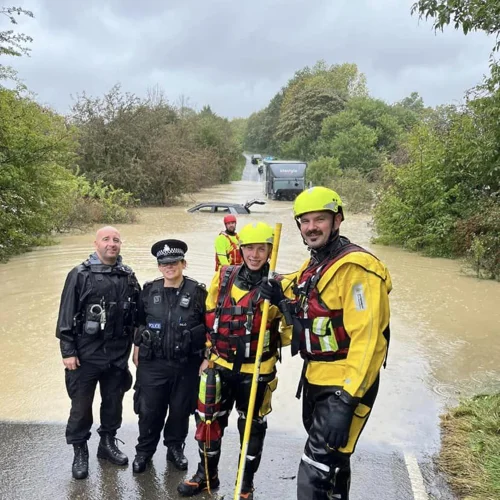Community overview
Geography
- Borders with Derbyshire, Leicestershire, Lincolnshire and South Yorkshire
- Over 300 miles of waterways, with several major rivers and canals passing through the county, including the River Trent
- The county is made up of eight local authority areas, with nine market towns and a thriving, and increasingly diverse, city
- 838 sq miles much of it rural land and forestry, including Sherwood Forest
Buildings and infrastructure
Over 6,000 tall buildings more than 11m in height
Over 180 residential buildings over 18m in height, of which over 150 are in the City
- 4,636 listed buildings, with 72 buildings on the Heritage At Risk Register
- Over 3,500 miles of road and motorway
- Over 20 miles of tramlines, with 37 trams and 50 stops across the network
- Two principal rail routes, the East Coast Main Line and Midland Mainline
Economic
- Nottingham City is ranked 11th out of 317 local authority districts, making it one of the most deprived in the country
- Nottinghamshire is ranked 101 out of 151 Upper Tier Local Authorities in England, with 1 bring the most deprived
- Mansfield is ranked 46 out of 317 local authority districts
- Rushcliffe is ranked 314 out of 317 local authority districts, making it one of the least deprived in the country
- The percentage of households experiencing fuel poverty varies from 10.6% in Rushcliffe to 18.1% in the City

Population
- Around half the county’s population live in and around Nottingham City
- Over 60,000 students in the City area, from two universities
- Almost 482,000 households in the county, of which 125,000 are in the City
Overall population of
1.15 million
people, over 70% living in urban areas
Health and lifestyle
- Smoking rates in the City and the Mansfield area are significantly higher than the national average at 21%. Within the County on average the rate is 12%, which is aligned to the national average
- 12,800 people are dependent on substances, alcohol being the most common
- Overall life expectancy in the City is 79 years and in the County it is 81 years which is close to the national average
Within the City, 17% of people report living with a long-term limiting illness or disability. Within the County, the equivalent figure is 20%.
Looking ahead
To ensure we can provide an effective service into the future, it is important to look ahead at the changes we might need to respond to.
In order to ensure that we can provide an effective service into the future, it is important that we look ahead at the changes which we might need to respond to.
We use an approach called PESTELO analysis to help with this, which involves assessing the political, economic, societal, technological, environmental, legal and organisational landscape to determine significant risks and drivers. The key insights from this are summarised below.
Political landscape
The election, in May 2024, of the first East Midlands Mayor may provide opportunities for accessing funding for specific initiatives and is likely, in the longer term, to see closer collaboration with Derbyshire Fire and Rescue Service.
Working in partnership, the National Employers (England), the National Fire Chiefs Council (NFCC) and the Local Government Association (LGA) have developed “Fit for the Future”, which defines what the fire and rescue sector aims to look like in the future and the challenges it faces in getting there. The previous Government had been pursuing fire sector reform and consulted on a White Paper in 2023. At the time of writing, we are awaiting further clarification on the direction the new Government intends to take in relation to sector reform.
Economic landscape
The high levels of inflation we have experienced during 2022-23 are abating but interest rates remain much higher than they have previously been. With continuing geo-political turbulence, there remains a risk to economic stability. Domestically, public sector spending in general, and in the fire sector in particular, is not expected to increase above the level of inflation in the coming years.
We are legally required to set a balanced budget, which is more challenging when we receive single-year funding settlements from the government. Nationally, the sector continues to lobby government for a longerterm funding settlement. In the meantime, we will need to continue to seek ways to improve our ways of working, restructure or redesign our services to live within our means.
Societal landscape
Our community constantly changes. Over the coming years we expect to see increasing diversity within the population of the City. Across the area, as nationally, the proportion of older people is growing, and more people are living alone and living at home with complex or chronic health conditions. Changes in health and lifestyle can affect the types and levels of risk we need to prepare for and the services we provide.

Technology landscape
Technology provides opportunities to make our processes more efficient, and to improve the accessibility of our services. However new technologies can also present new and emerging risks, which we will need to prepare for. For example, the growth in the use of lithium-ion batteries, in everything from disposable vapes to solar energy storage solutions presents new challenges for firefighting and fire prevention.

Artificial Intelligence (AI) presents both an opportunity and a threat. There will be opportunities to use AI-based tools to help improve the efficiency and effectiveness of our activities. The threat to cyber security is constant and ever-changing, and whilst AI can help us protect the Service from cyber crime, it is also something that criminals will use to attack organisations.
Environmental landscape
Extreme weather events are predicted to become increasingly frequent. They can lead to extensive wildfires and widescale flooding, of the kind we have responded to in recent years. This is already leading to changes in the way we train and equip our fire crews, and this will continue to be reviewed.

At the same time, we have a social responsibility to reduce our own carbon footprint, and will be working towards decarbonisation over the coming decade, including taking whatever steps we can to minimise the environmental impacts of our incident response activities.

Organisational landscape
As we work towards a more diverse workforce, we will need to ensure that we adapt to the needs of staff, including considering how we manage the physical demands of operational roles on an ageing workforce and balance the requirements of the Service against the diverse needs of our colleagues.
There will be a continuing focus on the health, safety and wellbeing of colleagues, especially in relation to issues such as contaminants and mental health.
With continuing national and political focus on culture and values within the emergency services, we will continue to nurture our positive and inclusive workplace culture.